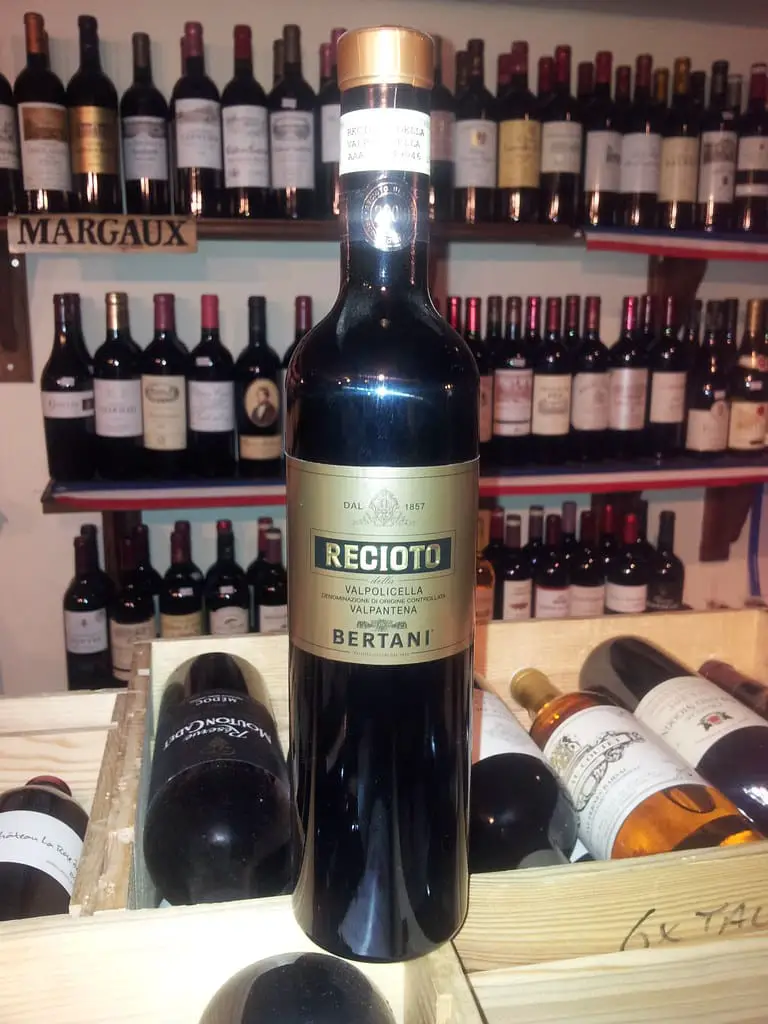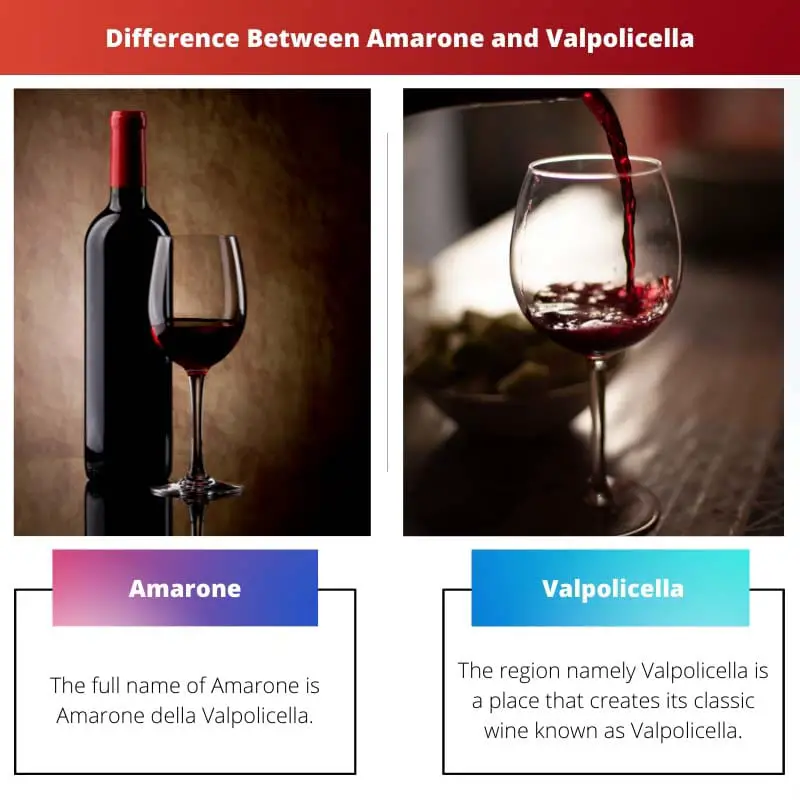When it comes to pasta, Italy is not only home for it but also for wines. The tourists and locals of Italy love to drink wine. If someone has not tasted Amarone and Valpolicella wines, then the person is missing a lot about Italy.
The origin of both these wines is the Valpolicella region.
Valpolicella is a place that is full of nature, wine, and rich culture. Tall mountains, clear busy streams, and luscious forests can be seen in this region. As a result, in this region, grapes grow healthfully.
In this article, the difference between wines, namely Amarone and Valpolicella, are highlighted.
Key Takeaways
- Amarone is a rich, full-bodied Italian wine made from partially dried grapes, while Valpolicella is a lighter, fruitier wine made from fresh grapes.
- Amarone undergoes a longer fermentation process, producing higher alcohol content than Valpolicella.
- Amarone wines are more expensive due to their labor-intensive production process and ageing requirements.
Amarone vs Valpolicella
The difference between Amarone and Valpolicella is their flavors. Amarone burst with flavors of prunes, dark chocolate, strawberry, raisins, and cinnamon spice. On the other hand, Valpolicella offers intensely concentrated flavors of raspberry, cinnamon, and wild strawberry.

The full name of Amarone is Amarone della Valpolicella. It is wine made in Valpolicella with partially dried grapes. Throughout the Valpolicella denomination, Amarone is produced from grapes which are dried until at least 1 December.
Invariably by Corvina, the flavors and aromas of Amarone are determined.
The region namely Valpolicella is a place that creates its classic wine known as Valpolicella. The rules of Valpolicella make sure that grapes must grow in a traditional way for their authenticity preservation.
That’s why systems of traditional training are permitted, such as Spallieta or Pergola Veronese.
Comparison Table
| Parameters of Comparison | Amarone | Valpolicella |
|---|---|---|
| Origin | 1938 | 1968 |
| Alcohol level | High (14.5-15.5%) | Moderate (around 11%) |
| Taste | Dry or off-dry | Sweet |
| Best used | Within 7-15 years | Within 3-5 years |
| Paired | With biased meat dishes, like bolognese or oxtail stew | With burgers, pasta, pizza, and grilled steaks |
What is Amarone?
Amarone is an Italian DOCG denomination that is of rich dry red wine and made from partially dried grapes namely Rondinella (5- 30%), Corvina (45- 95%), and other varieties of approved red wine which are up to 25%.
The name Amarone means “bitter.”
Originally, the name is given to distinguish from Recioto, which is produced in the same region, namely Valpolicella and sweeter.
Since ancient times, in Valpolicella, notable wines have been produced, but before 1953, the wine namely, Verona was not marketed as Amarone.
It was believed that in 1936, Adelino Lucchese was the one who coined the label Amarone. In December 1990, this wine was assigned the status of the DOC or Denominazione de Origine Controllata.
According to 2008, total production for sale was 8.57 million bottles, including recioto.
The production process of this wine, which is labor-intensive, poses a significant risk for the several wine faults development.
During harvest, rainy and wet weather might cause the rot of grapes before even drying out and requires diligence in removing rotted bunches by winemakers that can cause the flavor of moldy in the wine.

What is Valpolicella?
Valpolicella is a red wine that is made from the varieties of grapes such as Molinara, Veronese, Corvina, and Rondinella. In the area, a variety of wine styles is manufactured, consisting of Amarone and recioto dessert wine.
Most basic Valpolicella is light and fragrant table wines manufactured in Novello style.
At the end of fermentation, Valpolicella retains sugar content and gives sweetness, Valpolicella Classico is produced from grapes that are grown in the original production zone of Valpolicella.
When it comes to Valpolicella Superiore is aged for at least one year. Valpolicella Ripasso is made with grape skin that is partially dried and leftover from fermentation.
A range of wine styles are offered by Valpolicella and all are made from a combination of Rondinella, Corvinone, and Corvina grapes. Some of the winemakers might also be Oseleta and Molinara.
Each winery has a specific formula that equivalent specific terroir.
Valpolicella wine is made to be fresh and young and show the grape’s pure essence.
An archaeologist from Verona, namely Stefano De Stefani, made the first delimitation in 1881, the wine-making zone of Valpolicella, and documented all the traditional methods used there.

Main Differences Between Amarone and Valpolicella
- Amarone burst with flavors of prunes, dark chocolate, strawberry, raisins and cinnamon spice. Meanwhile, Valpolicella offers intensely concentrated flavors of raspberry, cinnamon, and wild strawberry.
- Amarone is made from the combination of grapes, namely Corvina, Rondinella, and Molinara. On the other hand, combination of grapes namely Rondinella, Corvinone, Oseleta, Corvina and Molinara are used in Valpolicella.
- When it comes to aging, for at least two years, Amarone must be aged starting in the year just after harvest. In contrast, Valpolicella must be aged at least one year.
- The origin of the word Amarone is from Italy, in which “amaro” means bitter. On the flip side, Valpolicella means the valley, which is of many cellars.
- To a drier style, Amarone wines will be fermented, and on the residual sugar some will reach double figures, but several down around 5g/l to 7g/l. Conversely, at the end of fermentation, Valpolicella retains sugar content and gives sweetness, starting at around residual sugar of 50g/l and upwards.

- https://onlinelibrary.wiley.com/doi/abs/10.1002/9781118569184.ch13
- https://www.sciencedirect.com/science/article/pii/0021967395009620

I appreciate the thoroughness of the comparison between Amarone and Valpolicella. It is a comprehensive piece that provides great insights.
This informative piece has certainly expanded my knowledge about these Italian wines.
Indeed, the article is very comprehensive.
This article presents the nuanced and intricate details about these wines in a clear and engaging manner. It is a commendable piece of writing.
The level of detail provided is truly impressive.
I have learned a lot from reading this article. It is exceptional.
I found the comparison table very illuminating. It makes it very easy to understand the differences between Amarone and Valpolicella.
Yes, the comparison table is a great addition.
Indeed, the specifics provided in the article are quite enlightening.
The article provides very detailed and useful information about Amarone and Valpolicella wines. It also contains a concrete comparison of these two products, which is greatly helpful for those who are interested in learning more about Italian wine.
I had been wanting to learn more about these wines. This article was very helpful for that.
I completely agree. It was a very informative read.
This is a fantastic article that thoroughly describes the characteristics and origins of Amarone and Valpolicella wines.
I believe the detailed description of the region and the wine-making processes greatly enhances the understanding of these wines. Engrossing read.
The article does an excellent job at capturing the essence of Amarone and Valpolicella.
The depth of information here is truly impressive.